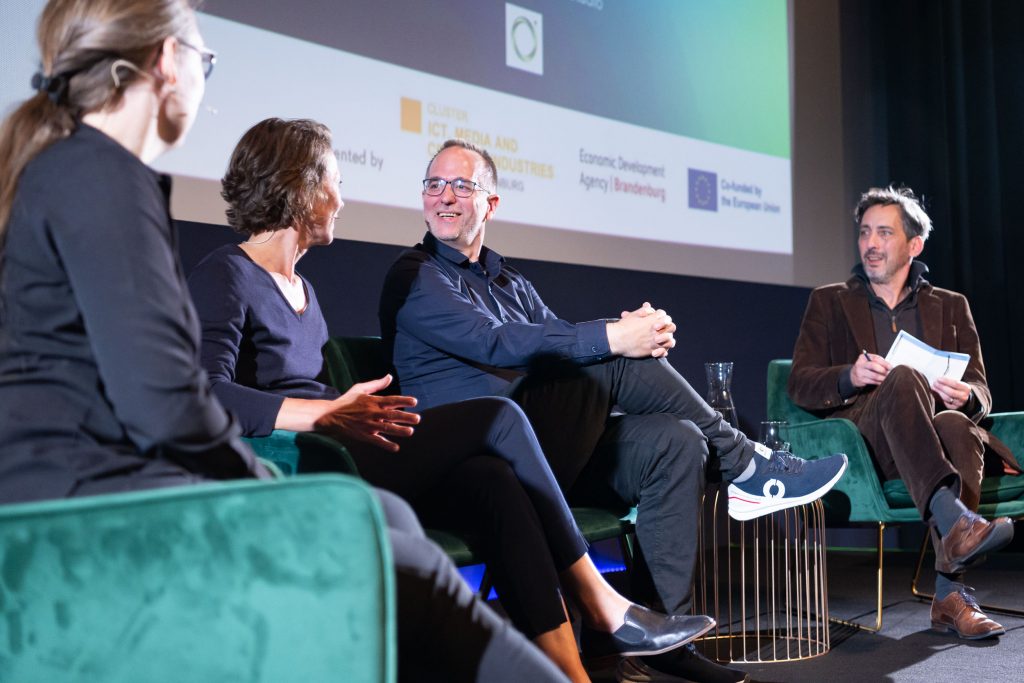What does sustainable venture building with the help of artificial intelligence look like? And how can it help Babelsberg as a location? This was the topic of the swiss serial entrepreneur Vincent Favrat talk at this year’s MediaTech Hub Conference. Favrat has been working at the intersection of the creative industries, technology, and innovation for many years. He is the founder of the venture studio “Oⁿ, the Symbiotic Venture Studio.”
MTH Potsdam: Hello Vincent. Thank you very much for taking the time to talk to us. To start with, I would like to ask you to briefly introduce yourself.
Vincent Favrat:
With pleasure, absolutely. My name is Vincent Favrat and I’m Swiss, which means I come from the French-speaking part of Switzerland. These days I live in Geneva, but I spent roughly 15 years of my life abroad – in Brussels, Paris, Berlin, and the United States.
I’m a serial entrepreneur, which means I found and build companies. Initially, I did this in the creative industries sector, and now I’m doing it in what I call the ‘Creative Tech’ space.
I started out in the music business. Among other things, I worked with Claude Nobs, the founder of the Montreux Jazz Festival in Switzerland. After that, I collaborated with Quincy Jones, the producer for Frank Sinatra and Michael Jackson. Together with him, I launched a platform called Qwest TV by Quincy Jones – it’s rather like ‘Netflix for music’, except as a Fast-Network-TV service with three channels.
Subsequently, I moved into film. I financed a portfolio of films, particularly in the area of film scores. And for two productions, I also worked directly in Babelsberg, including on a Warner Bros. project called “Lost Place” as well as on the film adaptation of Cornelia Funke’s children’s book “The Ghost Hunters on Icy Tracks”. For the second film, we also worked with the Babelsberg Film Orchestra, which was both an honour and a pleasure.
Overall, I’ve been involved in approximately 35 films, principally in the music domain, though on three projects I also served as co-producer.
With Arte, I then worked in the direction of video games. We released the game Homo Machina. It was a co-production between France and Germany and quite a considerable success.
And then I threw myself wholeheartedly into the technology sector. Among other ventures, I founded the company Musimap at that time. This was about personalised recommendations for music, films, or video games. It went very well indeed and resulted in a successful exit.
Following that, I’ve financed further startups in the creative industries and Creative Tech space. And now I’m founding a Venture Studio focused on the symbiotic creation of startups with the help of AI agents.
MTH Potsdam: We will indeed come back to that at a later point. But first, I would like to know what other connections you still have to Babelsberg?
Vincent Favrat:
Back then, I did live in Berlin, though I also spent considerable time in Potsdam and Babelsberg. With the ILB and other financiers from the region, I participated in several workshops and training programmes, such as Closing the Gap and other initiatives. These programmes prepared producers to raise private capital for film projects.
For me, Babelsberg and its history are deeply inspiring. I’m a great admirer of German Expressionism and many of those films I studied at the time. Studio Babelsberg is the oldest film studio in the world. It’s a historic location whose history is important and irreplaceable.
But generally speaking, there’s a great deal of interest to be found in Potsdam, particularly when one considers its history. The city has considerable culture, beauty, and a high quality of life. However, when it comes to marketing and storytelling, there’s more that could be done so that the Potsdam region and its surroundings become an even more leading centre of creativity in Europe. In my view, there’s still potential there that hasn’t been fully tapped.
MTH Potsdam: Although there are certainly efforts being made in this area. Potsdam has been designated a UNESCO Creative City of Film, for example.
Vincent Favrat:
Yes, I was also delighted to hear that news. However, I do think that Potsdam and the Babelsberg location could demonstrate a bit more confidence in themselves.
In the creative industries, particularly in the fields of Creative Tech and MediaTech, there are several centres across Europe, such as London, Paris, Barcelona, Amsterdam, and Stockholm. And in my view, Babelsberg, with strategic planning, could also reach such a level. This would further enhance its attractiveness to talent, developers, and start-up leaders – and not merely within Germany, but internationally.
MTH Potsdam: If you had to pitch Babelsberg to international investors, which three assets would you highlight? And where, if anywhere, would there be a gap that still needs to be filled?
Vincent Favrat:
The first point I would highlight would be the quality of life – this beautiful landscape, the culture, and the luxury of having a world metropolis, as it were, right on the doorstep.
The second point would be the history of Studio Babelsberg. It is the world’s first major film studio, and the artists who worked here had an enormous influence on Hollywood. What was created here is world cultural heritage.
The third point is the ecosystem of creatives, start-ups, and medium-sized enterprises, along with this already existing mixture of talent.
Regarding the last part of your question, I would say that, in my assessment, the ecosystem is too German. I would find a greater mix healthier – that is to say, 50 per cent German enterprises and 50 per cent international. My recommendation would be to welcome international talent and founders and to make it possible for them to establish enterprises in a straightforward manner.
The MediaTech Hub Conference is already a good step in that direction. It’s international and of high quality. I would build upon that in order to create an even stronger ecosystem.
But I’m looking at it from the outside, of course. This is the impression I gained from my visit to the MTH Conference in September.
MTH Potsdam: Let’s talk about the term “creative tech.” In your presentation at this year’s MTH Conference, you differentiated between “media tech” and “creative tech.” What is the difference between the two, and why do you prefer to use the term “creative tech”? Can you briefly describe what you mean by that?
Vincent Favrat:
For me, Creative Tech is centred around creativity and the creative industries. MediaTech, on the other hand, is for me somewhat more closely connected to media – radio, film, television, social media, and so forth.
That said, it’s certainly not always straightforward to distinguish between the two. Films, games, and design are indeed part of the creative industries, but one can equally view them as ‘media’. For that reason, I’m not strictly opposed to using the term ‘MediaTech’; I simply feel rather more at ease with ‘Creative Tech’ personally.
MTH Potsdam: In your opinion, what makes creative tech one of the fastest-growing investment categories in Europe? And which sub-segments are likely to attract the most investment in the future?
Vincent Favrat:
I believe that the term ‘Creative Tech’ is not yet strongly associated with investment. Venture capital and private equity funds tend to be connected with other sectors. In my view, there’s a gap here.
If one regards Creative Tech as an umbrella term, then one can actually find very substantial successes across Europe in this sector in terms of return on investment. Various examples include companies such as Spotify, which is worth approximately 120 billion euros, or Believe, which is a two-billion-euro venture from France in the music distribution space, or from the gaming sector Ubisoft, Supercell, or King.com – everyone knows, for instance, the mobile game “Candy Crush”.
In Europe, there was a development from 2014 through to the 2020s during which one could observe very substantial investments in the gaming sector. That hadn’t been the case previously. Mobile gaming created a value of over 100 billion euros within a decade.
After that, there were further major investments in video and streaming, some in the live culture sector, others in music, but also in edutainment and social media. Europe became a player in this space. Until 2020, I was able to identify investment rounds in my data that exceeded ten million euros. And the return on investment of this asset class is eight times as high. I find that remarkable.
MTH Potsdam: At the same time, many media tech or creative tech start-ups may win pilot projects, but then often fall by the wayside. What might local institutions need to do to turn pilot projects into annual contracts?
Vincent Favrat:
That’s a good question. From my perspective, the local ecosystem is there to enable one to take the first steps, which include pilots, amongst other things.
But for my understanding, it’s crucial not merely to create a start-up for the regional ecosystem, but rather one that is scalable. One should approach it ambitiously from the outset and pursue a business model that can be thought of globally or on a European scale. What are the countries I can target? That is to say, if a start-up has a brilliant idea, then that’s tremendously valuable and a good springboard.
For the local ecosystem, it must be better structured so that the next level can be reached. That also means that investment shouldn’t be directed only towards smaller start-ups, but also towards those aspiring to the next larger funding round. The winners should be retained within the ecosystem, because then there’s a return on investment as well. And they attract further enterprises.
If one were to structure and organise investment locally somewhat differently, then one might perhaps achieve 200 start-ups instead of 70. And there might well be a few genuine scale-ups among them, as well as one or two unicorns.
MTH Potsdam: You’ve already mentioned a good point. In the discussion about growth and sustainability, unicorns often stand for speed and scaling, while zebras stand for stability and social added value. What kind of startups do you think are best suited to Babelsberg or Brandenburg? Or do we perhaps need a category of our own that better reflects the region’s strengths?
Vincent Favrat:
The thing is, one needs both. It’s simply not the same profile. I believe that unicorns are important because they bring substantial growth and high dynamism with them. And they bring a particular profile of investors – venture capitalists. These venture capitalists can bring really significant capital to the table, enabling a project to reach a certain scale. That makes them a useful tool for greater impact as well. However, diversity among investors in the region is absolutely crucial. And through that, one can aspire to create a new wave and a different type of start-up.
At the same time, one also needs the smaller start-ups, which offer a specific solution to a specific problem. It doesn’t matter whether these start-ups comprise two or five people. What’s important is that it’s sustainable, that the product-market fit is sound. That creates value for the ecosystem as well. Together, we’re all stronger.
MTH Potsdam: Let’s come back to symbiotic venture building at the end. At the MTH Conference, you presented “Oⁿ, the Symbiotic Venture Studio.” What exactly is it all about?
Vincent Favrat:
My Symbiotic Venture Studio is rather like a ‘venture-building engine’. What we’ve done is look at where the focal points lie and where the greatest problems exist. Venture building is often a lengthy process – it’s difficult to secure funding, it’s not easy to obtain the right information, and conducting market analysis is challenging.
With Oⁿ, the Symbiotic Venture Studio, we’ve created a system that can solve these problems. It’s a co-pilot for innovators. The entire process is symbiotic in the sense that the AI doesn’t do all the work. Rather, it’s more like a dialogue that takes place. For example, it’s necessary to engage with customers in conversation in order to validate the business model.
A first step is to examine what the market looks like. Is there actually a market, and what does the supply landscape resemble? For this, the AI agents scan all public sources, from which they then generate reports and create sustainable business models.
Once I have a good business model in the next step, with our studio I receive a point of contact, rather like a large agency. Using the intelligence, I can then make my decisions.
In the next step, one can examine who the optimal customers and the right investors are. The AI agents search for them and create an overview, rather like a CRM system. That is to say, from day one, the entrepreneur can directly approach the right customers.
Subsequently, it’s about creating a business plan. This is done by the AI agents, though with questions posed to the entrepreneur. That way, it remains a kind of dialogue.
On the basis of all this information, it’s now possible to create an investor deck, an executive summary, and a financing model.
The idea behind the Venture Studio is that one can reach the end result up to ten times faster with venture building. Moreover, there’s also a matching component that can help find the right team members.
MTH Potsdam: Where do you think AI reduces risks in venture building?
Vincent Favrat:
There’s the problem that many start-ups are not successful. And with the help of such a system, certain risks can be avoided – though not through AI per se. If you ask a chatbot whether it can build you a business model, then there will indeed be an output, but the result is at best a crowd-pleaser. And the likelihood is very high that it will rather be an average start-up and will ultimately even fail.
What matters is quality. And you can make this quality scalable with the help of such a symbiotic system and increase the chances of success. That is to say, we help start-ups build sustainable business models and achieve their objectives.
Sustainability, for me, also means paying attention to wellbeing. There’s often this motto of going all out and being innovative, but without considering the consequences. For us, it’s far more responsible to provide the founder with the best possible chances. And we also have a system that tells you when something is going wrong or is too risky. There’s, for example, also a mental health component implemented in our system. So we help the entrepreneur make this venture-building journey easier, simpler, and to achieve a healthy work-life balance in the process.
MTH Potsdam: Finally, I would like to ask you if you can give an example of a venture that you have built up with the studio?
Vincent Favrat:
The first company we’ve created using this method is Nolej. It’s a French firm in the education sector. At the Global Edtech Startup Award, Nolej came in first place. It’s an AI platform for teachers, and it now has 500,000 customers worldwide, predominantly schools and universities, who use it.
MTH Potsdam: Vincent, thank you very much for talking to us!



